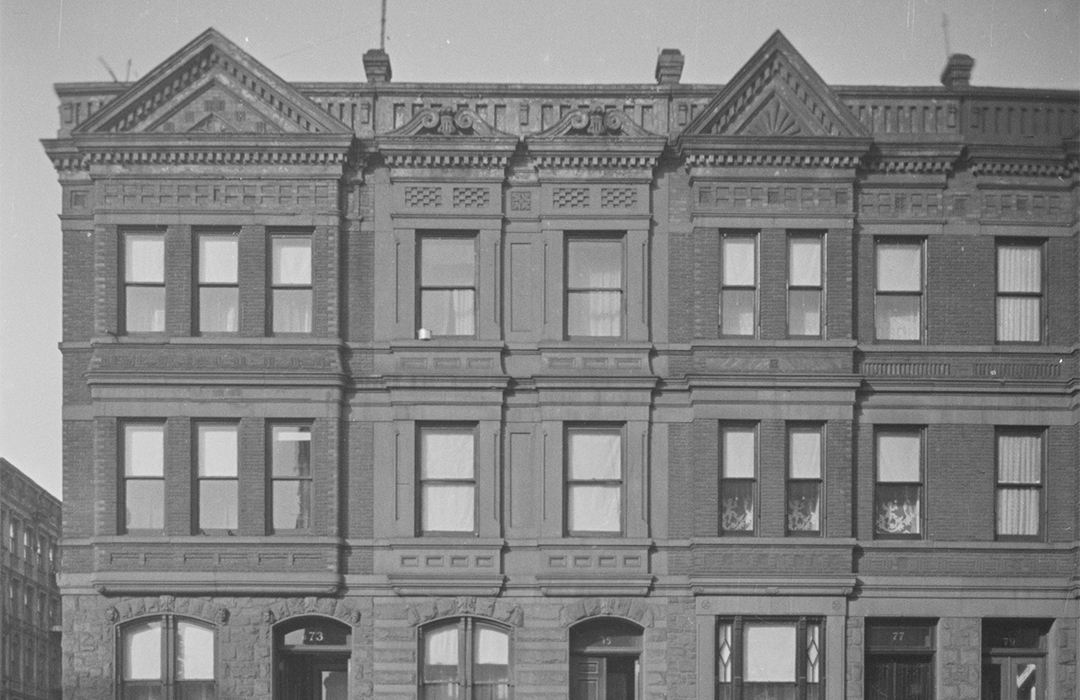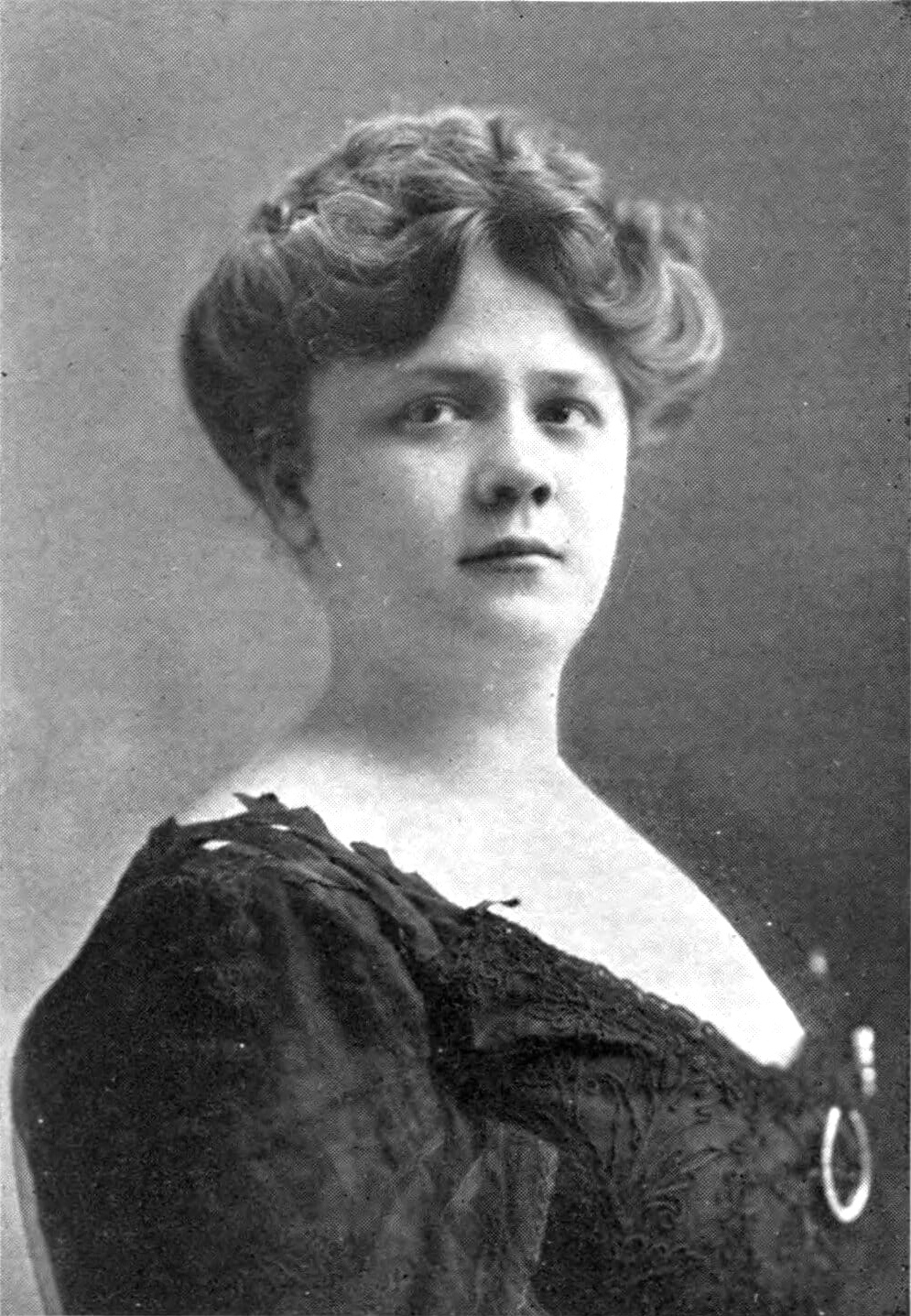
75 Manhattan Ave.
by Tom Miller
Real estate developer William John Davenport purchased building lots at 73 through 79 Manhattan Avenue in October 1890. Designed by William Howe, the six Queen Anne-style homes that Davenport erected on the site were completed the following year. Howe designed them as three pairs, in an A-B-C-C-B-A configuration.
No. 75 Manhattan Avenue was a B model. Three stories tall, its parlor level atop a high stoop was faced in rough-cut brownstone. Two slightly projecting bays at the second and third floors were capped with graceful swans-neck pediments.
The house became home to Stephen H. Davenport, the brother of William Davenport. Born in 1830, he and his brother traced their American lineage to John Davenport, who arrived in Boston in 1637. Stephen married Cornelia Stewart Russell on November 8, 1866. The couple had one child, Clara Russell, who was born two years later.
Six years after moving into 75 Manhattan Avenue, on November 18, 1897, Clara was married in the West End Presbyterian Church to Edwin B. Lapham. The New-York Tribune mentioned, “A reception followed at the home of the bride’s father, No. 75 Manhattan-ave.”
“Mr. Schneider knows Miss Carus and he didn’t think for a moment that she would send him such a telegram.”
By the early years of the 20th century, music publisher Ted Schneider occupied the house. On April 21, 1909, he received a telegram sent from the Hotel Knickerbocker. It read, “Meet me at the Hotel Victoria tonight. Out for a good time. Emma Carus.”
The Sun reported, “Mr. Schneider knows Miss Carus and he didn’t think for a moment that she would send him such a telegram.” (Emma Carus was a well-known vaudeville actress.) Schneider inquired at the hotel concerning who sent the telegram and discovered it was a girl about 15 years old and slender. When word reached Emma Carus at her home in Mount Vernon, she “came right down to town,” said The Sun, which added, “She was very, very angry and made Mr. Schneider promise that if he found out who sent the telegram he would let her know.”
On April 26, Marjorie Dean, a teenager who lived in Brooklyn, dropped into Schneider’s office to “get a few professional copies of late songs.” The Sun said, “she just had to tell him all about the little ‘joke’ she had played on him.” He had Marjorie wait while he sent for Emma Carus. Before long, the three “sat down together in Schneider’s office and talked it over.” Marjorie Dean no longer thought that the joke was funny. Although Emma was willing to forgive her, she thought that Marjorie could find better things “than chasing around sending telegrams to strange men under other women’s names.” Emma Carus had Marjorie arrested and sent to the Children’s Society.
The next occupant of 75 Manhattan Avenue was involved in a much more dire crime. Italian-born Alfredo Cocchi owned a motorcycle repair shop at 542 West 127th Street. He lived here with his young wife, Maria.
On February 13, 1917, 18-year-old Ruth Cruger went missing. Earlier that day, she had stopped into Cocchi’s shop to have her ice skates sharpened. Police interviewed Cocchi, who could not supply any information on her whereabouts. Two days later, he, too, disappeared. Maria Cocchi requested “a general alarm,” what today would be called a missing person report. She told the police that before going to work that day, he borrowed $5 from her and never returned home from the shop.
A month later, Henry D. Cruger, Ruth’s father, offered a $1,000 reward for information about his daughter and $500 for information on Cocchi’s whereabouts. Finally, in June, police went back to Cocchi’s shop. They found the teenager’s body buried in the basement. Alfredo Cocchi was tracked down to Bologna, Italy, where he confessed to the murder. He was tried in Italy and convicted unanimously.
The Fuchs family occupied 75 Manhattan Avenue during the World War I years. George Fuchs was a member of “The Jolly Pals,” a group of young Manhattan men. Every summer, the group would camp along the Palisades across the river from Riverside Park. At around 11 a.m. on June 16, 1918, during the third week of that year’s outing, seven of the members headed across the river to get supplies from Manhattan for dinner. The New York Sun explained, “Three of the men rode in one canoe and the second held four.” George Fuchs, who was 21 years old, and Charles Kaps, who was 19, were paddling the second boat.
They found the teenager’s body buried in the basement.
Suddenly a swell washed over the canoe. The Sun said that the other two men, Milton Meyer and Henry Zimmerman, 18 and 19 years old respectively, “became excited over the danger to the frail craft. In a moment the canoe capsized in full view of the Riverside Drive promenade.” Almost immediately, a rescue craft headed out. The article said, “Meyer and Zimmerman had not been able to keep afloat and they went down in midstream. The Rambler arrived in time to rescue Kaps and Fuchs.” The bodies of the other two were never recovered.
In September 1922, Patrick J. Conlon purchased both 73 and 75 Manhattan Avenue. He rented them, and in 1927, Roger Franklin Douglas and his wife, Minnie, lived in 75 Manhattan Avenue. Five years later, the Hughs family occupied the house. On May 21, 1932, Mrs. Hughs threw a large birthday party for her 17-year-old daughter Catherine. The Irish-American newspaper The Advocate reported, “The party, a most enjoyable one, was held at the ‘Old Log Cabin,’ 103d street and Columbus avenue.” Music was provided by the Old Log Cabin Band, and “Peggy Collins sang several songs that were a delight.” The article noted, “The party broke up at 3 a.m.”
The end for William Howe’s picturesque row came in the 1950s, when it and scores of other buildings in the neighborhood were replaced by the Frederick Douglass Houses, a sprawling urban renewal project.
Tom Miller is a social historian and blogger at daytoninmanhattan.blogspot.com



